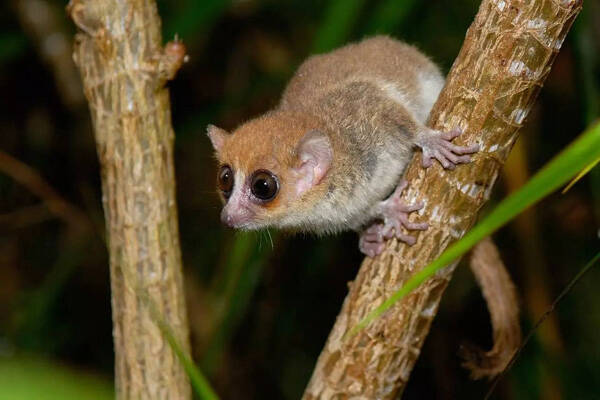Cheirogaleus major
IUCN
LCBasic Information
Scientific classification
- name:Cheirogaleus major
- Scientific Name:Cheirogaleus major,Mouse lemur
- Outline:Primates
- Family:Lemuridae
Vital signs
- length:12.6cm
- Weight:40-100g
- lifetime:About 11 years
Feature
It is the smallest species of primitive monkeys.
Distribution and Habitat
The mouse lemur is distributed in the moist woodlands and grasslands along the southwest coast of Madagascar, while the other species is found in the eastern and northern parts of the island. Due to the different forest habitats, the mountain subspecies and forest subspecies are produced, the populations are isolated, and the color difference also occurs.
Appearance
The mouse lemur is the smallest of the primitive monkeys, with a body length of about 12.6 cm, a tail length of about 13.2 cm, and a weight of 40 to 100 grams. The weight of an adult monkey varies with the season, but is usually around 60 grams. Those produced in the northeast are smaller and darker in color than those produced in the southwest. Their fur is generally brown-gray with varying shades of red and yellow, and their belly fur is light. They have round eyes and large ears, which are 22 to 28 mm long. There is a white stripe on the bridge of the nose, 36 teeth, and short limbs, especially the forelimbs.
Details
Mouse lemurs (scientific name: Cheirogaleus major) are arboreal animals.

Mouse lemurs are solitary nocturnal monkeys that sleep in groups in tree holes or leaves during the day. Several female monkeys often sleep in the same nest, sometimes up to 15, while male monkeys live alone or with their spouses. After nightfall, they go out to move around separately, running and jumping swiftly on the trees, chirping sharply, and looking for various insects, lizards, tree frogs, birds, wild fruits, and leaves. There are footprints on the trees and the ground, and the movement form is quadrupedal. They often use combs to groom their hair or chew bark, are good at using smell and urine to transmit information, have large ears and are active, and have large eyes with reflective membranes. All of this reflects the adaptation of mouse lemurs to nocturnal life. Since Madagascar is dry from July to September and food is scarce, they eat a lot before the end of the rainy season and store the fat they eat at the base of their tails. In the dry season, they use metabolic water to make up for the body's water needs. Generally speaking, 100 grams of fat can be completely oxidized to produce 110 grams of metabolic water. With this little water, mouse lemurs can safely survive the water-deficient dry season. When the base of their tails swells noticeably, their weight also increases accordingly.
Mouse lemurs have two birth peaks each year, from May to June and from November to January. The female gestation period is about 4 months, usually giving birth to 2 pups per litter, with a 16% chance of giving birth to 1 pup and an 8% chance of giving birth to 3 pups. They reach sexual maturity at 18-24 months. Under normal circumstances, their life span will exceed 11 years. What is special is that there is a natural chastity belt vaginal skin cover at the vaginal opening. When there is no estrus or delivery, this skin cover will close the vaginal opening, achieving a natural contraceptive effect.
The gestation period of mouse lemurs is 59 to 62 days. They can estrus twice a year, and the estrus period lasts 45 to 55 days. They give birth to 2 pups each time. It takes one and a half months for the baby monkeys to be weaned, and they can live independently after 2 months. They reach sexual maturity after 9 months.
In 1992, the mouse lemur, the smallest primate, was discovered in the deciduous forests of western Madagascar. Its total length is about 21 cm, of which more than 50% is the tail. An adult mouse lemur weighs about 30.6 grams, which is the weight of half a plum. (Guinness World Records)
Protect wildlife and eliminate game.
Maintaining ecological balance is everyone's responsibility!








